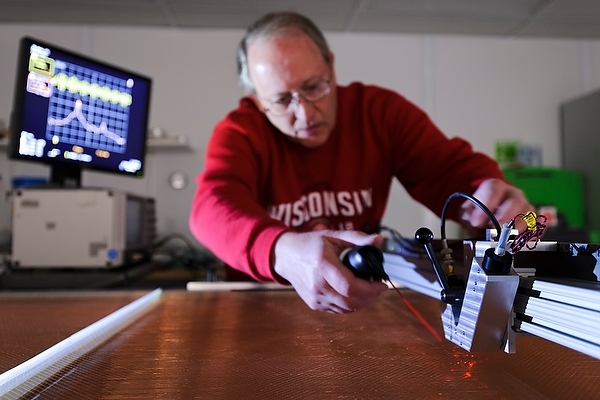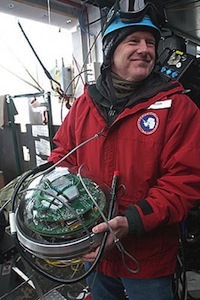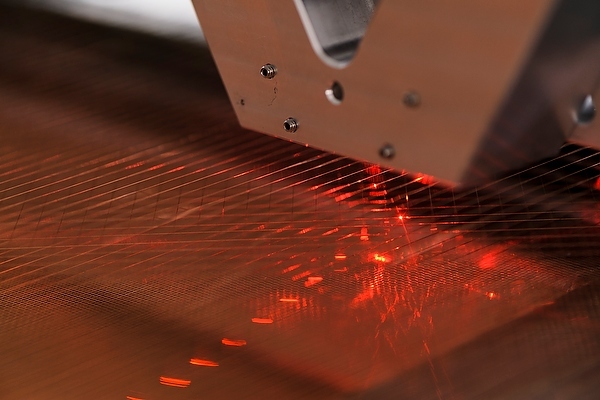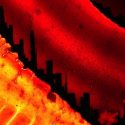PSL: Still making amazing instruments after all these years

Associate instrument innovator Dan Wahl uses a computer-controlled laser to measure the individual tension of thousands of tiny, woven wires that make up a prototype neutrino-target screen at the Physical Sciences Lab, or PSL.
A century ago, physicists used a tabletop “cloud chamber” to explore the motion of otherwise invisible particles. Today, they need giant machines to explore the bizarre frontiers of modern physics.
And significant components of the most important modern physics experiments in China, Switzerland, the U.S. and the South Pole can trace their roots to a lab across the road from a cornfield near Stoughton, Wisconsin.
The University of Wisconsin–Madison’s Physical Sciences Laboratory, or PSL, has built significant chunks of the Large Hadron Collider, where the discovery of an elementary particle called the Higgs boson is almost certain to earn a Nobel Prize.
“Our engineers have a great feel for how to work with scientists. There is a bit of art involved.”
Bob Paulos
PSL also built most of the 5,500-plus detectors buried in the ice at the South Pole for IceCube, which obtained the first view of a subatomic particle called the neutrino that originated beyond our galaxy. Neutrinos are the shyest animals in the particle zoo, and detecting them is astonishingly difficult. That find, by the UW-led IceCube project, was cited as the “breakthrough of the year” by the magazine Physics World in 2013.
These days, PSL is developing another neutrino detector destined to start operating in a mine in South Dakota around 2022. The Long-Baseline Neutrino Experiment, a nearly $1 billion project funded by the Department of Energy, will detect neutrinos and check whether they can morph from one variety to another.

Bob Paulos
So even after a budget shortfall forced the closing of the Synchrotron Radiation Center next door, the remaining half of the Kegonsa Research Campus is still going strong, says PSL interim director Bob Paulos.
Paulos attributes PSL’s enviable record of supplying premier experiments globally to two key advantages.
“Some places have fancier equipment or a bigger staff,” he says, “but the proximity of our engineers to a shop with very good capabilities is a significant help in making sure that our hardware does exactly what it should. Our engineers have a great feel for how to work with scientists. There is a bit of art involved.”
Second, Paulos says, “we excel at the integration of many components. To build and make parts, and then test them, you need the right kind of experience, and you have to learn that on the job.”
The big jobs get the glory, but the engineers, welders and machinists at PSL also excel at small projects for investigators across campus, such as an “ozone annihilator” for a genetics lab and an instrument to monitor combustion at the Engine Research Center.
“Basic research is always about the unknown, but history shows that you may stumble on something, or find some useful application for your science.”
Bob Paulos
“We like spending time on small projects because the variety is interesting, and you never know where it is going to lead,” says Paulos.
PSL has a program with limited funding for designing and building equipment for student and faculty research projects. “I can’t remember anybody saying that a project was too small,” says Paulos, who was the longtime project manager at IceCube.
Paulos plans to offer training to UW–Madison students in the fall. “They will be designing, building, writing code, whatever they can do,” he says. “That gives students practical experience, and the benefit of working alongside seasoned professionals.”
Thirty-five people work at PSL, giving the lab considerable economic impact in the area, Paulos says. “We have people doing engineering, working in the shop, working with local suppliers, buying connectors (and) PC boards from the Fox Valley.”

PSL is creating prototype neutrino-target screens for the Long-Baseline Neutrino Experiment, set to begin operation in 2022.
The detectors that PSL is prototyping for the Long-Baseline Neutrino Experiment resemble ultra-high-tech window screens. Eventually the lab will build and mount at least 80 assemblies, each roughly 8 by 23 feet. “That’s $20 million worth of work,” says Paulos, “and nearly all the money will be spent in the state.”
The experiment’s goal is to learn whether neutrinos change their nature while moving at the speed of light. But why should we care, since billions of neutrinos course unnoticed through our bodies each minute?
“Basic research is always about the unknown,” says Paulos, “but history shows that you may stumble on something, or find some useful application for your science.
“When the X-rays were discovered 120 years ago, they turned out to be very beneficial — and a great aid in understanding the nature of reality. Today, very few people know about neutrinos. I’m not saying the same thing will happen with neutrinos, but it could.”
Tags: research



